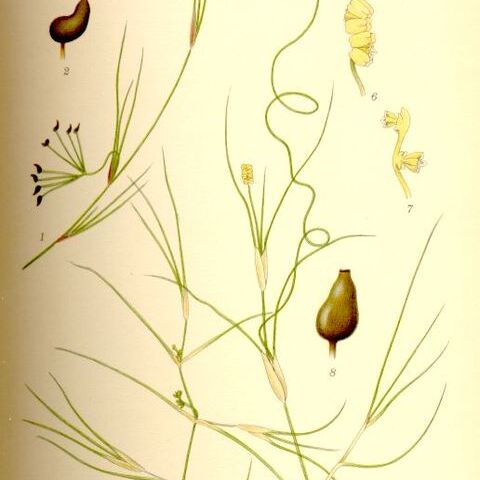length. Winter buds present or absent, with one internode, the leaves undiffer-entiated. Inflorescence a 1-to few-flowered capitate spike enclosed in a spathe-like sheath; peduncle elongating at anthesis, elevating the inflorescence to or near the water's surface. Flowers bisporangiate; perianth absent; stamens 2, sessile; carpels 2-16, distinct, stipitate, placentation parietal, ovule one. Fruits drupa-ceous, dorsally rounded, each on a short stipe which usually elongates after anthesis.
Plants herbaceous, submersed in brackish or saline waters, annual or peren-nial, propagating from seeds, rhizomes, or winter buds. Stems variable in length according to water depth, branched or unbranched, terete, rooting at the nodes. Leaves all submersed, sub-opposite or alternate, linear or setaceous, uninervate, with a stipular sheath at the base, apex acute to truncate, margins entire through-out or minutely serrulate at the apex; stipule adnate to leaf base for its entire
Herbs, rooting at proximal nodes. Leaves: blade entire proximally, minutely serrulate distally, apex ± obtuse to acute; veins 1. Inflorescences fewer than 20-flowered, at first enclosed by sheathing leaf bases. Flowers bisexual; anthers 2-loculed, locules separated by broad connective; stipe elongating after anthesis. Fruits beaked, long-stipitate; beak erect or slightly recurved.
Slender completely submerged herbs forming colonies with intricately branched stems up to 80 cm. long. Roots simple, 1-2 per node, covered with very long root-hairs. Leaves with spreading blades to 10 cm. long and 1 mm. wide; sheaths stipular in origin. Flowers inconspicuous when young, but fruits prominent, appearing subumbellate because of the stipitate drupes.
Morphological characters and geographical distribution are the same as those of the family.
Characters of the family.

